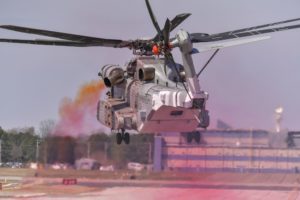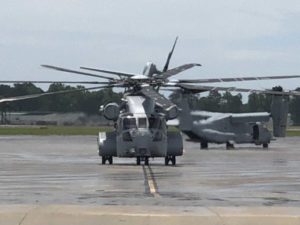The Naval Air Systems Command (NAVAIR) said a team of government and industry engineers have solved and mitigated an engine integration issue for the CH-53K King Stallion helicopter this week.
During flight tests, the Marine Corps found several design deficiencies in the aircraft, including a re-ingestion of exhaust into the helicopter’s three engines. These issues delayed operational testing and pushed back the CH-53K’s entry into service to at least 2021 (Defense Daily, May 6).

The Navy said a “tiger team” of experts from various engineering backgrounds found and optimized aircraft modifications using computational modeling methodologies, risk management, flight data, and systems engineering tools. The team started work in April 2019. It included experts on engine performance, computational fluid dynamics, modeling and simulation, materials, structures, logistics, systems safety, reliability and maintainability, flight test, and fire protection and survivability.
PMA-261 assistant program manager engineering and the program office’s chief engineer Debbie Cleavenger said three engines created several integration issues for the aircraft, including the most troublesome: exhaust gas re-ingestion (EGR).
“EGR occurs when the hot engine gasses are ingested back into the system. It can cause anything from increased life-cycle costs, poor engine performance and degradation, time-on-wing decreases, engine overheating and even engine stalls,” Cleavenger said.
NAVAIR spokeswoman Megan Wasel told Defense Daily the team “completed more than 30 test scenarios and evaluated 135 potential design corrections before replicating the model with the most promising modification for rigorous actual flight testing. Four test flights and nearly 13 hours of flight testing validated that modification as the solution to mitigating EGR.”
Team members worked on different root cause analyses at the same time, figuring out the cause and developing design models to mitigate EGR causes. Then, iterative flight testing validated models to find the best model solution.
In turn, that model was used to build components for one of the test aircraft that flew a series of test flights to collect data to validate the model.
NAVAIR said the flight test data was then “condensed, analyzed and presented in December 2019 to show that the result performed as predicted and provided an overall design modification that would meet the needs for fleet aircraft.”
Wasel said the final modifications to mitigate EGR include exhaust duct geometry changes, increasing air flow into engine bays, adding heat shields, and minor alterations to engine software.
“This is exactly what an integrated test team is supposed to do. Bring their expertise to a project, look for resolutions in a dynamic and collaborative environment, determine the best path forward and keep this aircraft on track to the fleet,” Col. Jack Perrin, heavy lift helicopter program office PMA-261 program manager, said in a statement.

Cleavanger noted significant system contraints, where “one change impacted multiple systems.”
“Bringing together the tiger team exemplifies the importance and purpose of an integrated test team. It was great to see the team turn the corner for the program and produce a resolution to an ongoing problem. This was a priority for NAVAIR, industry and the Marine Corps, and the team hit it out of the park,” Perrin, added.
Wasel told Defense Daily one test aircraft has been modified for the solution, but “it would not be cost-effective or beneficial to the program to modify the other test aircraft. All CH-53K King Stallions built for the fleet will incorporate the production solution.”
Of the 126 technical issues that require design updates before deployment, 101 have a design solution while the rest “are on track to be resolved within the CH-53Ks test timeline,” Wasel continued.
The Defense Department’s Director of Test and Evaluation (DOT&E) annual report published in January disclosed the multiple deficiencies in the aircraft that would push back its entry into service. DOT&E reported the design deficiencies included airspeed indication anomalies, low reliability of the main rotor gearbox, hot gas impingement on aircraft structures, tail boom and tail rotor structural problems, overheating of main rotor dampers, fuel system anomalies, high temperatures in the number-two engine bay and hot gas ingestion by the number-two engine that could reduce available power (Defense Daily, Jan. 31).
In April, the Navy’s top acquisition official James Geurts told the Senate Armed Services Subcommittee on Seapower that issues with the King Stallion would be fixed in the production aircraft when they roll off production lines. He said most of the design flaws had either been corrected or there was a plan in place to correct them at the time, which was his goal for restructuring the program when he took over in December 2017 (Defense Daily, April 14).
The CH-53K program plans to continuing completion of the developmental test leading to Initial Operation Test and Evaluation in 2021.
The first fleet deployment for the King Stallion is scheduled for 2023/24, Wasel added.
Once the CH-53K enters service, it will be the largest single-rotor helicopter in the U.S. military inventory, able to carry 27,000 pounds of cargo 100 miles. Compared to the 9,000 pounds the current CH-53E can carry, the King Stallion will triple the Marine Corps’ ship-to-shore lift capacity.
The CH-53K is powered by three General Electric [GE] T-408 engines, which the Navy said are more powerful and efficient than the current T-64 engines on the CH-53E.